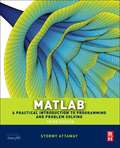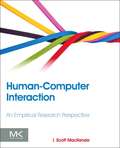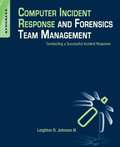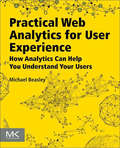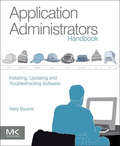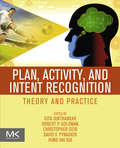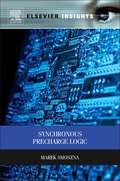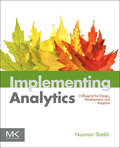- Table View
- List View
Matlab: A Practical Introduction To Programming And Problem Solving (PDF)
by Stormy AttawayMATLAB has become the standard software tool for solving scientific and engineering problems due to its powerful built-in functions and its ability to program. Assuming no knowledge of programming, this book guides the reader through both programming and built-in functions to easily exploit MATLAB's extensive capabilities for tackling engineering problems. The book starts with programming concepts, such as variables, assignments, and selection statements, moves on to loops, and then solves problems using both the programming concept and the power of MATLAB. In-depth coverage is given to input/output, a topic fundamental to many engineering applications. The third edition of MATLAB: A Practical Introduction to Programming and Problem Solving has been updated to reflect the functionality of the current version of MATLAB. It features new and revised end-of-chapter exercises, stronger coverage of loops and vectorizing, and more engineering applications to help the reader learn this software tool in context. Presents programming concepts and MATLAB built-in functions side-by-side Systematic, step-by-step approach, building on concepts throughout the book, facilitating easier learning Sections on common pitfalls and programming guidelines direct students towards best practice
Human-Computer Interaction: An Empirical Research Perspective (PDF)
by I. Scott MackenzieHuman-Computer Interaction: An Empirical Research Perspective is the definitive guide to empirical research in HCI. The book begins with foundational topics including historical context, the human factor, interaction elements, and the fundamentals of science and research.
Total Information Risk Management: Maximizing the Value of Data and Information Assets
by Ajith Kumar Parlikad Alexander Borek Jela Webb Philip WoodallHow well does your organization manage the risks associated with information quality? Managing information risk is becoming a top priority on the organizational agenda. The increasing sophistication of IT capabilities along with the constantly changing dynamics of global competition are forcing businesses to make use of their information more effectively. Information is becoming a core resource and asset for all organizations; however, it also brings many potential risks to an organization, from strategic, operational, financial, compliance, and environmental to societal. If you continue to struggle to understand and measure how information and its quality affects your business, this book is for you. This reference is in direct response to the new challenges that all managers have to face. Our process helps your organization to understand the "pain points" regarding poor data and information quality so you can concentrate on problems that have a high impact on core business objectives. This book provides you with all the fundamental concepts, guidelines and tools to ensure core business information is identified, protected and used effectively, and written in a language that is clear and easy to understand for non-technical managers. Shows how to manage information risk using a holistic approach by examining information from all sourcesOffers varied perspectives of an author team that brings together academics, practitioners and researchers (both technical and managerial) to provide a comprehensive guideProvides real-life case studies with practical insight into the management of information risk and offers a basis for broader discussion among managers and practitioners
Analyzing the Social Web
by Jennifer GolbeckAnalyzing the Social Web provides a framework for the analysis of public data currently available and being generated by social networks and social media, like Facebook, Twitter, and Foursquare. Access and analysis of this public data about people and their connections to one another allows for new applications of traditional social network analysis techniques that let us identify things like who are the most important or influential people in a network, how things will spread through the network, and the nature of peoples' relationships. Analyzing the Social Web introduces you to these techniques, shows you their application to many different types of social media, and discusses how social media can be used as a tool for interacting with the online public. Presents interactive social applications on the web, and the types of analysis that are currently conducted in the study of social media. Covers the basics of network structures for beginners, including measuring methods for describing nodes, edges, and parts of the network. Discusses the major categories of social media applications or phenomena and shows how the techniques presented can be applied to analyze and understand the underlying data. Provides an introduction to information visualization, particularly network visualization techniques, and methods for using them to identify interesting features in a network, generate hypotheses for analysis, and recognize patterns of behavior. Includes a supporting website with lecture slides, exercises, and downloadable social network data sets that can be used can be used to apply the techniques presented in the book.
The Basics of Cloud Computing: Understanding the Fundamentals of Cloud Computing in Theory and Practice
by Derrick Rountree Ileana CastrilloAs part of the Syngress Basics series, The Basics of Cloud Computing provides readers with an overview of the cloud and how to implement cloud computing in their organizations. Cloud computing continues to grow in popularity, and while many people hear the term and use it in conversation, many are confused by it or unaware of what it really means. This book helps readers understand what the cloud is and how to work with it, even if it isn’t a part of their day-to-day responsibility. Authors Derrick Rountree and Ileana Castrillo explains the concepts of cloud computing in practical terms, helping readers understand how to leverage cloud services and provide value to their businesses through moving information to the cloud. The book will be presented as an introduction to the cloud, and reference will be made in the introduction to other Syngress cloud titles for readers who want to delve more deeply into the topic. This book gives readers a conceptual understanding and a framework for moving forward with cloud computing, as opposed to competing and related titles, which seek to be comprehensive guides to the cloud. Provides a sound understanding of the cloud and how it worksDescribes both cloud deployment models and cloud services models, so you can make the best decisions for deploymentPresents tips for selecting the best cloud services providers
Heterogeneous Computing with OpenCL: Revised OpenCL 1.2 Edition
by David R. Kaeli Perhaad Mistry Dana Schaa Benedict Gaster Lee HowesHeterogeneous Computing with OpenCL, Second Edition teaches OpenCL and parallel programming for complex systems that may include a variety of device architectures: multi-core CPUs, GPUs, and fully-integrated Accelerated Processing Units (APUs) such as AMD Fusion technology. It is the first textbook that presents OpenCL programming appropriate for the classroom and is intended to support a parallel programming course. Students will come away from this text with hands-on experience and significant knowledge of the syntax and use of OpenCL to address a range of fundamental parallel algorithms. Designed to work on multiple platforms and with wide industry support, OpenCL will help you more effectively program for a heterogeneous future. Written by leaders in the parallel computing and OpenCL communities, Heterogeneous Computing with OpenCL explores memory spaces, optimization techniques, graphics interoperability, extensions, and debugging and profiling. It includes detailed examples throughout, plus additional online exercises and other supporting materials that can be downloaded at http://www.heterogeneouscompute.org/?page_id=7 This book will appeal to software engineers, programmers, hardware engineers, and students/advanced students.Explains principles and strategies to learn parallel programming with OpenCL, from understanding the four abstraction models to thoroughly testing and debugging complete applications.Covers image processing, web plugins, particle simulations, video editing, performance optimization, and more.Shows how OpenCL maps to an example target architecture and explains some of the tradeoffs associated with mapping to various architecturesAddresses a range of fundamental programming techniques, with multiple examples and case studies that demonstrate OpenCL extensions for a variety of hardware platforms
The Basics of Cyber Warfare: Understanding the Fundamentals of Cyber Warfare in Theory and Practice
by Jason Andress Steve WinterfeldThe Basics of Cyber Warfare provides readers with fundamental knowledge of cyber war in both theoretical and practical aspects. This book explores the principles of cyber warfare, including military and cyber doctrine, social engineering, and offensive and defensive tools, tactics and procedures, including computer network exploitation (CNE), attack (CNA) and defense (CND). Readers learn the basics of how to defend against espionage, hacking, insider threats, state-sponsored attacks, and non-state actors (such as organized criminals and terrorists). Finally, the book looks ahead to emerging aspects of cyber security technology and trends, including cloud computing, mobile devices, biometrics and nanotechnology. The Basics of Cyber Warfare gives readers a concise overview of these threats and outlines the ethics, laws and consequences of cyber warfare. It is a valuable resource for policy makers, CEOs and CIOs, penetration testers, security administrators, and students and instructors in information security.Provides a sound understanding of the tools and tactics used in cyber warfare. Describes both offensive and defensive tactics from an insider's point of view. Presents doctrine and hands-on techniques to understand as cyber warfare evolves with technology.
Distributed Computing Through Combinatorial Topology
by Sergio Rajsbaum Maurice Herlihy Dmitry KozlovDistributed Computing Through Combinatorial Topology describes techniques for analyzing distributed algorithms based on award winning combinatorial topology research. The authors present a solid theoretical foundation relevant to many real systems reliant on parallelism with unpredictable delays, such as multicore microprocessors, wireless networks, distributed systems, and Internet protocols. Today, a new student or researcher must assemble a collection of scattered conference publications, which are typically terse and commonly use different notations and terminologies. This book provides a self-contained explanation of the mathematics to readers with computer science backgrounds, as well as explaining computer science concepts to readers with backgrounds in applied mathematics. The first section presents mathematical notions and models, including message passing and shared-memory systems, failures, and timing models. The next section presents core concepts in two chapters each: first, proving a simple result that lends itself to examples and pictures that will build up readers' intuition; then generalizing the concept to prove a more sophisticated result. The overall result weaves together and develops the basic concepts of the field, presenting them in a gradual and intuitively appealing way. The book's final section discusses advanced topics typically found in a graduate-level course for those who wish to explore further. Named a 2013 Notable Computer Book for Computing Methodologies by Computing ReviewsGathers knowledge otherwise spread across research and conference papers using consistent notations and a standard approach to facilitate understandingPresents unique insights applicable to multiple computing fields, including multicore microprocessors, wireless networks, distributed systems, and Internet protocols Synthesizes and distills material into a simple, unified presentation with examples, illustrations, and exercises
Computer Incident Response and Forensics Team Management: Conducting a Successful Incident Response
by Leighton JohnsonComputer Incident Response and Forensics Team Management provides security professionals with a complete handbook of computer incident response from the perspective of forensics team management. This unique approach teaches readers the concepts and principles they need to conduct a successful incident response investigation, ensuring that proven policies and procedures are established and followed by all team members. Leighton R. Johnson III describes the processes within an incident response event and shows the crucial importance of skillful forensics team management, including when and where the transition to forensics investigation should occur during an incident response event. The book also provides discussions of key incident response components.Provides readers with a complete handbook on computer incident response from the perspective of forensics team managementIdentify the key steps to completing a successful computer incident response investigationDefines the qualities necessary to become a successful forensics investigation team member, as well as the interpersonal relationship skills necessary for successful incident response and forensics investigation teams
Principles of Big Data: Preparing, Sharing, and Analyzing Complex Information
by Jules J. BermanPrinciples of Big Data helps readers avoid the common mistakes that endanger all Big Data projects. By stressing simple, fundamental concepts, this book teaches readers how to organize large volumes of complex data, and how to achieve data permanence when the content of the data is constantly changing. General methods for data verification and validation, as specifically applied to Big Data resources, are stressed throughout the book. The book demonstrates how adept analysts can find relationships among data objects held in disparate Big Data resources, when the data objects are endowed with semantic support (i.e., organized in classes of uniquely identified data objects). Readers will learn how their data can be integrated with data from other resources, and how the data extracted from Big Data resources can be used for purposes beyond those imagined by the data creators. Learn general methods for specifying Big Data in a way that is understandable to humans and to computersAvoid the pitfalls in Big Data design and analysisUnderstand how to create and use Big Data safely and responsibly with a set of laws, regulations and ethical standards that apply to the acquisition, distribution and integration of Big Data resources
Risk Management Framework: A Lab-Based Approach to Securing Information Systems
by James BroadThe RMF allows an organization to develop an organization-wide risk framework that reduces the resources required to authorize a systems operation. Use of the RMF will help organizations maintain compliance with not only FISMA and OMB requirements but can also be tailored to meet other compliance requirements such as Payment Card Industry (PCI) or Sarbanes Oxley (SOX). With the publishing of NIST SP 800-37 in 2010 and the move of the Intelligence Community and Department of Defense to modified versions of this process, clear implementation guidance is needed to help individuals correctly implement this process. No other publication covers this topic in the detail provided in this book or provides hands-on exercises that will enforce the topics. Examples in the book follow a fictitious organization through the RMF, allowing the reader to follow the development of proper compliance measures. Templates provided in the book allow readers to quickly implement the RMF in their organization. The need for this book continues to expand as government and non-governmental organizations build their security programs around the RMF. The companion website provides access to all of the documents, templates and examples needed to not only understand the RMF but also implement this process in the reader’s own organization.A comprehensive case study from initiation to decommission and disposalDetailed explanations of the complete RMF process and its linkage to the SDLCHands on exercises to reinforce topicsComplete linkage of the RMF to all applicable laws, regulations and publications as never seen before
The Moderator's Survival Guide: Handling Common, Tricky, and Sticky Situations in User Research
by Donna Tedesco Fiona TranquadaThe Moderator's Survival Guide is your indispensable resource for navigating the rocky shoals of your one-on-one user research sessions. Inside, you’ll find guidance for nearly 100 diverse situations (ranging from business-as-usual to tricky and sticky) that might occur during usability studies, contextual inquiries, or user interviews. As a moderator, you are responsible for the well-being of the participant, your study, and your organization. You must be prepared for anything that may happen, from your technology failing to the participant quailing. Use this guide to identify your best next steps, react appropriately, and survive any challenges that comes your way. Practical, field-tested, and actionable tips for what to do and say—and what NOT to do or say—in each situation.Key patterns and extensive examples to sharpen your approach to the commonplace and prepare you for the unlikely.Illustrative "survival stories" contributed by numerous professionals on the front lines of user research.
Digital Outcasts: Moving Technology Forward without Leaving People Behind
by Kel SmithThe blind person who tries to make an online purchase. The young girl who cannot speak due to a cognitive disability. The man confined to his home due to permanent injury. The single mother with a long-term illness who struggles to feed her family. With one in seven people worldwide currently living with a disability, the term "outcast" covers numerous scenarios. Digital outcasts rely on technology for everyday services that many people take for granted. However, poorly designed products risk alienating this important (and growing) population. Through a "grass roots" approach to innovation, digital outcasts are gradually taking action to transform their lives and communities. This emerging trend provides exciting learning opportunities for all of us. Citing real-world case studies from healthcare to social science, this book examines the emerging legal and cultural impact of inclusive design. Gain a better understanding of how people with disabilities use technology Discover pitfalls and approaches to help you stay current in your UX practices Anticipate a future in which ambient benefit can be achieved for people of all abilities and backgrounds
Practical Web Analytics for User Experience: How Analytics Can Help You Understand Your Users
by Michael BeasleyPractical Web Analytics for User Experience teaches you how to use web analytics to help answer the complicated questions facing UX professionals. Within this book, you'll find a quantitative approach for measuring a website's effectiveness and the methods for posing and answering specific questions about how users navigate a website. The book is organized according to the concerns UX practitioners face. Chapters are devoted to traffic, clickpath, and content use analysis, measuring the effectiveness of design changes, including A/B testing, building user profiles based on search habits, supporting usability test findings with reporting, and more. This is the must-have resource you need to start capitalizing on web analytics and analyze websites effectively.Discover concrete information on how web analytics data support user research and user-centered design Learn how to frame questions in a way that lets you navigate through massive amounts of data to get the answer you needLearn how to gather information for personas, verify behavior found in usability testing, support heuristic evaluation with data, analyze keyword data, and understand how to communicate these findings with business stakeholders
Cloud Computing: Theory and Practice
by Dan C. MarinescuCloud Computing: Theory and Practice provides students and IT professionals with an in-depth analysis of the cloud from the ground up. Beginning with a discussion of parallel computing and architectures and distributed systems, the book turns to contemporary cloud infrastructures, how they are being deployed at leading companies such as Amazon, Google and Apple, and how they can be applied in fields such as healthcare, banking and science. The volume also examines how to successfully deploy a cloud application across the enterprise using virtualization, resource management and the right amount of networking support, including content delivery networks and storage area networks. Developers will find a complete introduction to application development provided on a variety of platforms.Learn about recent trends in cloud computing in critical areas such as: resource management, security, energy consumption, ethics, and complex systems Get a detailed hands-on set of practical recipes that help simplify the deployment of a cloud based system for practical use of computing clouds along with an in-depth discussion of several projectsUnderstand the evolution of cloud computing and why the cloud computing paradigm has a better chance to succeed than previous efforts in large-scale distributed computing
Applied Cyber Security and the Smart Grid: Implementing Security Controls into the Modern Power Infrastructure
by Eric D. Knapp Raj SamaniMany people think of the Smart Grid as a power distribution group built on advanced smart metering—but that’s just one aspect of a much larger and more complex system. The "Smart Grid" requires new technologies throughout energy generation, transmission and distribution, and even the homes and businesses being served by the grid. This also represents new information paths between these new systems and services, all of which represents risk, requiring a more thorough approach to where and how cyber security controls are implemented. This insight provides a detailed architecture of the entire Smart Grid, with recommended cyber security measures for everything from the supply chain to the consumer.Discover the potential of the Smart GridLearn in depth about its systemsSee its vulnerabilities and how best to protect it
Professional Penetration Testing: Creating and Learning in a Hacking Lab
by Thomas WilhelmProfessional Penetration Testing walks you through the entire process of setting up and running a pen test lab. Penetration testing—the act of testing a computer network to find security vulnerabilities before they are maliciously exploited—is a crucial component of information security in any organization. With this book, you will find out how to turn hacking skills into a professional career. Chapters cover planning, metrics, and methodologies; the details of running a pen test, including identifying and verifying vulnerabilities; and archiving, reporting and management practices. Author Thomas Wilhelm has delivered penetration testing training to countless security professionals, and now through the pages of this book you can benefit from his years of experience as a professional penetration tester and educator. After reading this book, you will be able to create a personal penetration test lab that can deal with real-world vulnerability scenarios. All disc-based content for this title is now available on the Web.Find out how to turn hacking and pen testing skills into a professional careerUnderstand how to conduct controlled attacks on a network through real-world examples of vulnerable and exploitable serversMaster project management skills necessary for running a formal penetration test and setting up a professional ethical hacking businessDiscover metrics and reporting methodologies that provide experience crucial to a professional penetration tester
CCTV: From Light to Pixels
by Vlado DamjanovskiThe new edition of CCTV, a high-level professional reference, is expanded to cover all video compression techniques used in the ever-increasing assortment of digital video recorders (DVRs) available on the market today. In addition to demystifying DVR technology, the third edition also clarifies the technology of data networking and explains various compression techniques. Along with all this, the book retains the particulars that made the previous editions convenient and valuable, including details of CCD cameras, lenses, coaxial cables, fiber-optics, and system design. Updated to address digital techniques, networking, and the Internet in closed-circuit televisionIncludes brand new sections on CCTV networking, digital video recorders (DVRs), various video compression techniques, and understanding pixels and digital image qualityFully illustrated with dozens of photographs, tables, checklists, charts, diagrams, and instructions
Unified Communications Forensics: Anatomy of Common UC Attacks
by Nicholas Mr. Grant Joseph II ShawUnified Communications Forensics: Anatomy of Common UC Attacks is the first book to explain the issues and vulnerabilities and demonstrate the attacks, forensic artifacts, and countermeasures required to establish a secure (UC) environment. This book is written by leading UC experts Nicholas Grant and Joseph W. Shaw II and provides material never before found on the market, including: • analysis of forensic artifacts in common UC attacks • an in-depth look at established UC technologies and attack exploits • hands-on understanding of UC attack vectors and associated countermeasures • companion website http://secvoip.com giving readers access to the most up-to-date information on UC attacks.Provides key information for hackers and pen testers on the most current Unified Communications implementationsThe only book to explore and demonstrate how to work with digital artifacts from attacks within the UC environmentDeals with UC security from multiple angles—less about theory and more about hands-on threat defense and forensics
Conformal Prediction for Reliable Machine Learning: Theory, Adaptations and Applications
by Vladimir Vovk Vineeth Balasubramanian Shen-Shyang HoThe conformal predictions framework is a recent development in machine learning that can associate a reliable measure of confidence with a prediction in any real-world pattern recognition application, including risk-sensitive applications such as medical diagnosis, face recognition, and financial risk prediction. Conformal Predictions for Reliable Machine Learning: Theory, Adaptations and Applications captures the basic theory of the framework, demonstrates how to apply it to real-world problems, and presents several adaptations, including active learning, change detection, and anomaly detection. As practitioners and researchers around the world apply and adapt the framework, this edited volume brings together these bodies of work, providing a springboard for further research as well as a handbook for application in real-world problems.Understand the theoretical foundations of this important framework that can provide a reliable measure of confidence with predictions in machine learningBe able to apply this framework to real-world problems in different machine learning settings, including classification, regression, and clusteringLearn effective ways of adapting the framework to newer problem settings, such as active learning, model selection, or change detection
Visual Usability: Principles and Practices for Designing Digital Applications
by Tania Schlatter Deborah LevinsonImagine how much easier creating web and mobile applications would be if you had a practical and concise, hands-on guide to visual design. Visual Usability gets into the nitty-gritty of applying visual design principles to complex application design. You’ll learn how to avoid common mistakes, make informed decisions about application design, and elevate the ordinary. We’ll review three key principles that affect application design – consistency, hierarchy, and personality – and illustrate how to apply tools like typography, color, and layout to digital application design. Whether you’re a UI professional looking to fine-tune your skills, a developer who cares about making applications beautiful and usable, or someone entirely new to the design arena, Visual Usability is your one-stop, practical guide to visual design.Discover the principles and rules that underlie successful application design Learn how to develop a rationale to support design strategy and move teams forwardMaster the visual design toolkit to increase user-friendliness and make complicated processes feel straightforward for your product
Application Administrators Handbook: Installing, Updating and Troubleshooting Software
by Kelly C BourneAn application administrator installs, updates, optimizes, debugs and otherwise maintains computer applications for an organization. In most cases, these applications have been licensed from a third party, but they may have been developed internally. Examples of application types include enterprise resource planning (ERP), customer resource management (CRM), and point of sale (POS), legal contract management, time tracking, accounts payable/receivable, payroll, SOX compliance tracking, budgeting, forecasting and training. In many cases, the organization is absolutely dependent that these applications be kept running. The importance of application administrators and the level to which organizations depend upon them is easily overlooked. Application Administrators Handbook provides an overview of every phase of administering an application, from working with the vendor before installation, the installation process itself, importing data into the application, handling upgrades, working with application users to report problems, scheduling backups, automating tasks that need to be done on a repetitive schedule, and finally retiring an application. It provides detailed, hands-on instructions on how to perform many specific tasks that an application administrator must be able to handle. Learn how to install, administer and maintain key software applications throughout the product life cycleGet detailed, hands-on instructions on steps that should be taken before installing or upgrading an application to ensure continuous operationIdentify repetitive tasks and find out how they can be automated, thereby saving valuable timeUnderstand the latest on government mandates and regulations, such as privacy, SOX, HIPAA, PCI, and FISMA and how to fully comply
Plan, Activity, and Intent Recognition: Theory and Practice
by Gita Sukthankar, Christopher Geib, Hung Hai Bui, David V. Pynadath and Robert P. GoldmanPlan recognition, activity recognition, and intent recognition together combine and unify techniques from user modeling, machine vision, intelligent user interfaces, human/computer interaction, autonomous and multi-agent systems, natural language understanding, and machine learning. Plan, Activity, and Intent Recognition explains the crucial role of these techniques in a wide variety of applications including: personal agent assistants computer and network security opponent modeling in games and simulation systems coordination in robots and software agents web e-commerce and collaborative filtering dialog modeling video surveillance smart homes In this book, follow the history of this research area and witness exciting new developments in the field made possible by improved sensors, increased computational power, and new application areas.Combines basic theory on algorithms for plan/activity recognition along with results from recent workshops and seminarsExplains how to interpret and recognize plans and activities from sensor dataProvides valuable background knowledge and assembles key concepts into one guide for researchers or students studying these disciplines
Synchronous Precharge Logic
by Marek SmosznaPrecharge logic is used by a variety of industries in applications where processor speed is the primary goal, such as VLSI (very large systems integration) applications. Also called dynamic logic, this type of design uses a clock to synchronize instructions in circuits. This comprehensive book covers the challenges faced by designers when using this logic style, including logic basics, timing, noise considerations, alternative topologies and more. In addition advanced topics such as skew tolerant design are covered in some detail. Overall this is a comprehensive view of precharge logic, which should be useful to graduate students and designers in the field alike. It might also be considered as a supplemental title for courses covering VLSI.Comprehensive guide to precharge logicExplains both the advantages and disadvantages to help engineers decide when to utilize precharge logicUseful for engineers in a variety of industries
Implementing Analytics: A Blueprint for Design, Development, and Adoption (The Morgan Kaufmann Series on Business Intelligence)
by Nauman SheikhImplementing Analytics demystifies the concept, technology and application of analytics and breaks its implementation down to repeatable and manageable steps, making it possible for widespread adoption across all functions of an organization. Implementing Analytics simplifies and helps democratize a very specialized discipline to foster business efficiency and innovation without investing in multi-million dollar technology and manpower. A technology agnostic methodology that breaks down complex tasks like model design and tuning and emphasizes business decisions rather than the technology behind analytics.Simplifies the understanding of analytics from a technical and functional perspective and shows a wide array of problems that can be tackled using existing technologyProvides a detailed step by step approach to identify opportunities, extract requirements, design variables and build and test models. It further explains the business decision strategies to use analytics models and provides an overview for governance and tuningHelps formalize analytics projects from staffing, technology and implementation perspectivesEmphasizes machine learning and data mining over statistics and shows how the role of a Data Scientist can be broken down and still deliver the value by building a robust development process
